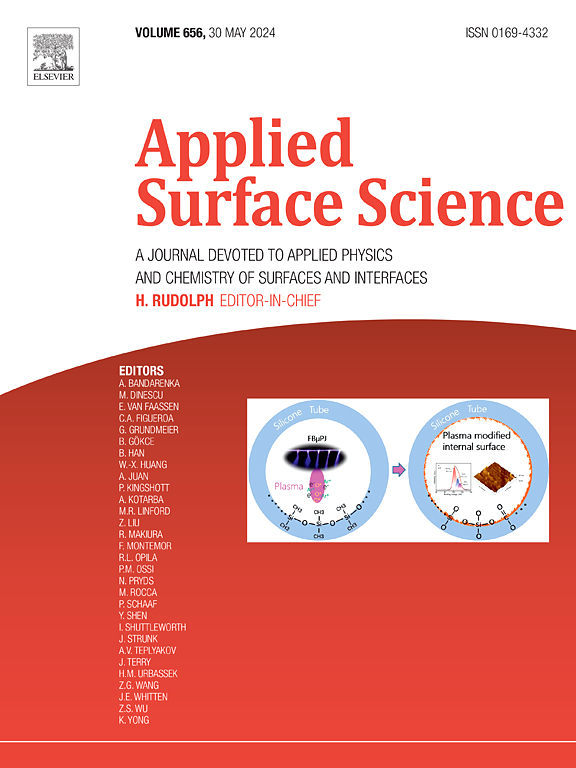Phosphorylated ZVI composites with self-activating interfaces: Synergistic multi-metal removal via in-situ Fe-Cu galvanic coupling and Zn-mediated passivation inhibition
IF 6.3
2区 材料科学
Q2 CHEMISTRY, PHYSICAL
引用次数: 0
Abstract
Zero-valent iron (ZVI) is recognized as an eco-friendly material for heavy metal remediation, yet its application was constrained by surface passivation. A mechanical ball milling method was utilized to synthesize phosphorylated ZVI (ZVI/PR) through incorporation of natural phosphate rock (PR), where PO43--induced corrosion was harnessed to enhance sustained Fe(II) release. The ZVI/PR removed 70 % Cr(VI) within 24 h in the single-metal system, which was significantly increased to 97 % and 77 % in Cu(II)-Cr(VI) and Zn(II)-Cr(VI) binary-metal system, respectively. The apparent reaction rate constants increased by 1.4 and 4.34 times with the presence of Zn(II) and Cu(II). Mechanistic investigations revealed two synergistic pathways: 1) Cu(II) was adsorbed and reduced to Cu(0) onto the ZVI/PR surface forming Fe-Cu bimetallic interfaces, which established galvanic cells that enhanced electron transfer; 2) Zn(II) inhibited the formation of Fe3+ oxide layer, preserving reactive sites and reducing passivation. This dual mechanism facilitated simultaneous removal of Cu(II)/Zn(II)/Cr(VI) through synergistic redox and adsorption processes. The use of industrial byproduct phosphate rock, combined with mechanochemical activation, presented a cost-effective surface engineering strategy. This approach enabled multi-contaminant remediation via controlled interfacial corrosion and modulated electron transfer of ZVI.

具有自活化界面的磷酸化ZVI复合材料:通过原位Fe-Cu电偶联和zn介导的钝化抑制协同去除多金属
零价铁(Zero-valent iron, ZVI)是一种环保的重金属修复材料,但其应用受到表面钝化的限制。采用机械球磨法通过掺入天然磷矿(PR)合成磷酸化的ZVI (ZVI/PR),利用PO43诱导的腐蚀来增强Fe(II)的持续释放。ZVI/PR在24 h内对Cu(II)-Cr(VI)和Zn(II)-Cr(VI)二元金属体系的Cr(VI)去除率分别达到97 %和77 %。Zn(II)和Cu(II)的存在使反应速率常数分别提高了1.4倍和4.34倍。机理研究揭示了两种协同作用途径:1)Cu(II)在ZVI/PR表面吸附并还原为Cu(0),形成Fe-Cu双金属界面,建立了增强电子转移的原电池;2) Zn(II)抑制了Fe3+氧化层的形成,保留了活性位点,减少了钝化。这种双重机制有利于通过协同氧化还原和吸附过程同时去除Cu(II)/Zn(II)/Cr(VI)。利用工业副产品磷矿,结合机械化学活化,提出了一种具有成本效益的地面工程策略。该方法通过控制界面腐蚀和调节ZVI的电子转移,实现了多污染物的修复。
本文章由计算机程序翻译,如有差异,请以英文原文为准。
求助全文
约1分钟内获得全文
求助全文
来源期刊

Applied Surface Science
工程技术-材料科学:膜
CiteScore
12.50
自引率
7.50%
发文量
3393
审稿时长
67 days
期刊介绍:
Applied Surface Science covers topics contributing to a better understanding of surfaces, interfaces, nanostructures and their applications. The journal is concerned with scientific research on the atomic and molecular level of material properties determined with specific surface analytical techniques and/or computational methods, as well as the processing of such structures.
 求助内容:
求助内容: 应助结果提醒方式:
应助结果提醒方式:


